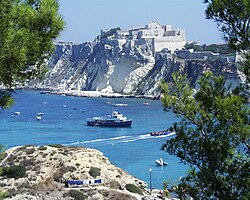Loading AI tools
Comune in Apulia, Italy From Wikipedia, the free encyclopedia
The Tremiti Islands (Italian: Isole Tremiti, Italian pronunciation: [ˈiːzole ˈtrɛːmiti]), also literarily known as Isole Diomedee ("Diomedean Islands", from Greek Διομήδεες Diomédees), are an archipelago in the Adriatic Sea, north of the Gargano Peninsula. They constitute a comune of Italy's Province of Foggia, Apulia and form part of the Gargano national park. The archipelago is composed of 5 islands: San Domino, San Nicola, Capraia, Cretaccio, and Pianosa.[3]
Tremiti Islands
Isole Tremiti | |
|---|---|
| Comune di Isole Tremiti | |
 A view of San Nicola island from the nearby San Domino island, with the Abbey of Santa Maria a Mare fortified complex. | |
 Tremiti within the Province of Foggia | |
| Coordinates: 42°07′N 15°30′E | |
| Country | Italy |
| Region | Apulia |
| Province | Foggia (FG) |
| Frazioni | Isola San Nicola, Isola San Domino |
| Government | |
| • Mayor | Antonio Fentini |
| Area | |
| • Total | 3.13 km2 (1.21 sq mi) |
| Elevation | 70 m (230 ft) |
| Population (May 2021)[2] | |
| • Total | 454 |
| • Density | 150/km2 (380/sq mi) |
| Demonym | Tremitesi |
| Time zone | UTC+1 (CET) |
| • Summer (DST) | UTC+2 (CEST) |
| Postal code | 71051 |
| Dialing code | 0882 |
| ISTAT code | 071026 |
| Patron saint | Our Lady of Assumption |
| Saint day | 15 August |
| Website | Official website |
The islands were used for the internment of political prisoners during Benito Mussolini's Fascist regime.[4] It was also the prison of Julia the Younger, the granddaughter of Augustus.
The islands are now an important tourist attraction because of the clear waters surrounding them. Up to 100,000 visitors come to the islands in the summer season.[5] Ferry services from the mainland operate from Termoli, Vieste, Rodi Garganico and Capoiale,[6] while Alidaunia offers flights from San Domino Heliport to Foggia and Vieste.[7]
The origin of the name of the islands is uncertain. Some of the theories include:
Inhabited since late Iron Age times (4th-3rd centuries BC), the Tremiti Islands have been a place of confinement since ancient times. Roman emperor Augustus had his granddaughter Julia the Younger transferred here, where she died after 20 years. In the Middle Ages, the archipelago was ruled by the Abbey of Santa Maria a Mare ("Holy Mary on the Sea") at San Nicola island, apparently founded here in the 9th century by Benedictine monks from Montecassino.
In the 13th century, the abbey had gained its autonomy from the father monastery, and owned lands from the Biferno to Trani on the Apulian mainland. After an alleged period of moral decadence, in 1237 the Benedictines were replaced by the Cistercian order. In 1334 the abbey was sacked by Dalmatian pirates from Omiš.
In 1412 the Lateran Canons took ownership of the islands and restored the abbey with cisterns and fortifications which withstood the assault of Ottoman ships in 1567. The abbey was suppressed in 1783 by King Ferdinand IV of Naples, who set up a penal colony.
During the Napoleonic age the islands were a stronghold of Joachim Murat's supporters, who resisted a British fleet in 1809. In 1843, to repopulate the islands, King Ferdinand II of Two Sicilies moved a number of people from Naples' slums to the islands, who mostly became fishermen.
In 1911, about 1,300 Libyans who had resisted Italian colonial rule were confined to Tremiti. After a year, around one-third of them had died, mainly from typhus.
During the Fascist era, the archipelago continued to perform its function of confinement, detaining, among others, Amerigo Dumini, and future president of the Republic, Sandro Pertini.
Mussolini had hundreds of homosexuals deported to San Domino, in 1938. No law prohibited homosexuality at the time, and Mussolini also denied its existence, saying, "In Italy, there are only real men".[citation needed] However, suspected or reported homosexuals were rounded up and deported. San Domino had the distinction of being the only internment camp in which all the prisoners were gay.[9] The conditions on the island were very difficult, and a few died.[10]
The dormitories were spartan, with no electricity or running water.[9] A bell would ring at 8 p.m. each day, signaling that the men were no longer allowed to be outside. For the remainder of the night, they were locked in their dorm rooms, under police supervision.[9]
The internment camp closed in 1939, as Italy became enmeshed in the beginnings of World War II.[9]
In May 2012, the provincial government caused a scandal by attempting to sell off blocks of land on two of the islands for development for a reported €4m. Local environmental groups campaigned vigorously and in the event, there were no bidders.[11]
Seamless Wikipedia browsing. On steroids.
Every time you click a link to Wikipedia, Wiktionary or Wikiquote in your browser's search results, it will show the modern Wikiwand interface.
Wikiwand extension is a five stars, simple, with minimum permission required to keep your browsing private, safe and transparent.